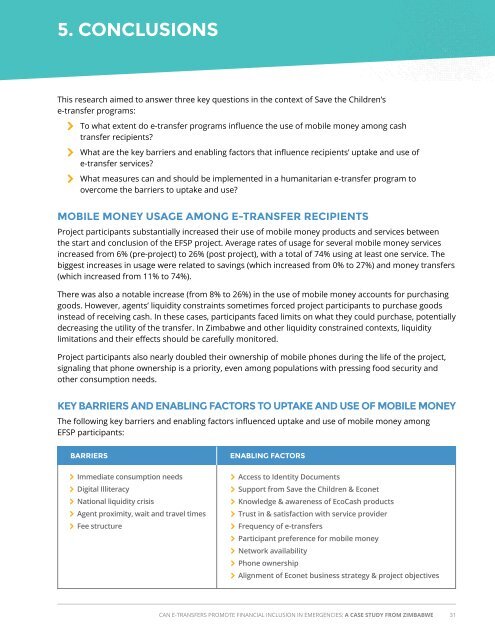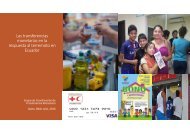Simatelele
2lF850q
2lF850q
You also want an ePaper? Increase the reach of your titles
YUMPU automatically turns print PDFs into web optimized ePapers that Google loves.
5. CONCLUSIONS<br />
This research aimed to answer three key questions in the context of Save the Children’s<br />
e-transfer programs:<br />
To what extent do e-transfer programs influence the use of mobile money among cash<br />
transfer recipients?<br />
What are the key barriers and enabling factors that influence recipients’ uptake and use of<br />
e-transfer services?<br />
What measures can and should be implemented in a humanitarian e-transfer program to<br />
overcome the barriers to uptake and use?<br />
MOBILE MONEY USAGE AMONG E-TRANSFER RECIPIENTS<br />
Project participants substantially increased their use of mobile money products and services between<br />
the start and conclusion of the EFSP project. Average rates of usage for several mobile money services<br />
increased from 6% (pre-project) to 26% (post project), with a total of 74% using at least one service. The<br />
biggest increases in usage were related to savings (which increased from 0% to 27%) and money transfers<br />
(which increased from 11% to 74%).<br />
There was also a notable increase (from 8% to 26%) in the use of mobile money accounts for purchasing<br />
goods. However, agents’ liquidity constraints sometimes forced project participants to purchase goods<br />
instead of receiving cash. In these cases, participants faced limits on what they could purchase, potentially<br />
decreasing the utility of the transfer. In Zimbabwe and other liquidity constrained contexts, liquidity<br />
limitations and their effects should be carefully monitored.<br />
Project participants also nearly doubled their ownership of mobile phones during the life of the project,<br />
signaling that phone ownership is a priority, even among populations with pressing food security and<br />
other consumption needs.<br />
KEY BARRIERS AND ENABLING FACTORS TO UPTAKE AND USE OF MOBILE MONEY<br />
The following key barriers and enabling factors influenced uptake and use of mobile money among<br />
EFSP participants:<br />
BARRIERS ENABLING FACTORS<br />
Immediate consumption needs<br />
Digital Illiteracy<br />
National liquidity crisis<br />
Agent proximity, wait and travel times<br />
Fee structure<br />
Access to Identity Documents<br />
Support from Save the Children & Econet<br />
Knowledge & awareness of EcoCash products<br />
Trust in & satisfaction with service provider<br />
Frequency of e-transfers<br />
Participant preference for mobile money<br />
Network availability<br />
Phone ownership<br />
Alignment of Econet business strategy & project objectives<br />
CAN E-TRANSFERS PROMOTE FINANCIAL INCLUSION IN EMERGENCIES: A CASE STUDY FROM ZIMBABWE 31



